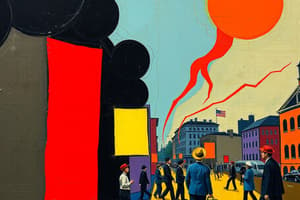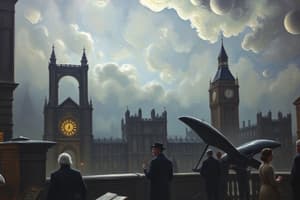Podcast
Questions and Answers
Which of the following was NOT a key factor contributing to the economic worries in the United States during the late 1920s?
Which of the following was NOT a key factor contributing to the economic worries in the United States during the late 1920s?
- Increasingly relaxed credit standards by the American banking system (correct)
- A collapsing international debt structure after World War I
- Struggling key industries like construction and agriculture
- Rising unemployment rates
The growth of oligopolies in the decade before the Great Depression helped to stabilize the American economy during the initial downturn.
The growth of oligopolies in the decade before the Great Depression helped to stabilize the American economy during the initial downturn.
False (B)
What percentage of national unemployment was reached by 1933 during the Great Depression?
What percentage of national unemployment was reached by 1933 during the Great Depression?
25%
President Hoover's approach to handling the Great Depression, known as _______, relied on the honor code of fair business practices and realistic labor expectations.
President Hoover's approach to handling the Great Depression, known as _______, relied on the honor code of fair business practices and realistic labor expectations.
Match the following programs or policies with their descriptions during the Hoover Administration:
Match the following programs or policies with their descriptions during the Hoover Administration:
What was a significant failing of Herbert Hoover's approach to the Great Depression?
What was a significant failing of Herbert Hoover's approach to the Great Depression?
Franklin Delano Roosevelt shared virtually no political views in common with Herbert Hoover.
Franklin Delano Roosevelt shared virtually no political views in common with Herbert Hoover.
What term did Franklin Delano Roosevelt use to describe his approach to directing the American economy during the Great Depression?
What term did Franklin Delano Roosevelt use to describe his approach to directing the American economy during the Great Depression?
The various programs introduced during the Roosevelt administration were collectively known as _______ agencies.
The various programs introduced during the Roosevelt administration were collectively known as _______ agencies.
Match the following New Deal agencies with their general purpose:
Match the following New Deal agencies with their general purpose:
Which statement best describes the impact of the New Deal on the Great Depression?
Which statement best describes the impact of the New Deal on the Great Depression?
The New Deal was universally praised by all Americans at the time for its effectiveness and fairness.
The New Deal was universally praised by all Americans at the time for its effectiveness and fairness.
Aside from FDR, who else within his administration was instrumental in bringing awareness of the plight of women, blacks and other minority groups?
Aside from FDR, who else within his administration was instrumental in bringing awareness of the plight of women, blacks and other minority groups?
The event that ultimately brought the United States economy roaring back after the Great Depression was the attack on ______.
The event that ultimately brought the United States economy roaring back after the Great Depression was the attack on ______.
Match each event to its corresponding year:
Match each event to its corresponding year:
What was one key concern economists had regarding the international debt structure created after WWI?
What was one key concern economists had regarding the international debt structure created after WWI?
During the Great Depression, marriage, divorce, and birth rates all increased as families sought stability and support from one another.
During the Great Depression, marriage, divorce, and birth rates all increased as families sought stability and support from one another.
What made President Hoover a unique individual compared to all other Presidents of the US at the time of his election?
What made President Hoover a unique individual compared to all other Presidents of the US at the time of his election?
Roosevelt surrounded himself with highly-motivated and educated advisors he called the _______.
Roosevelt surrounded himself with highly-motivated and educated advisors he called the _______.
Match the term from the Roosevelt era with its description.
Match the term from the Roosevelt era with its description.
Flashcards
Sick Industries (1920s)
Sick Industries (1920s)
Key sectors like construction, agriculture, and coal struggled, leading to piling inventories and rising joblessness.
Oligopolies Role in Depression
Oligopolies Role in Depression
A concentration of economic power in a few firms, led to inflexible pricing and amplified economic shocks.
American Work Ethic
American Work Ethic
The belief that hard work was essential, which was challenged by mass unemployment.
Hoover's Response to Depression
Hoover's Response to Depression
Signup and view all the flashcards
Voluntarism
Voluntarism
Signup and view all the flashcards
The New Deal
The New Deal
Signup and view all the flashcards
Alphabet Soup Agencies
Alphabet Soup Agencies
Signup and view all the flashcards
Impact of the New Deal
Impact of the New Deal
Signup and view all the flashcards
Eleanor Roosevelt's Role
Eleanor Roosevelt's Role
Signup and view all the flashcards
End of the Great Depression
End of the Great Depression
Signup and view all the flashcards
Study Notes
- By the late 1920s, economists in the United States were concerned about the state of key industries such as construction, agriculture, and coal.
- Inventories were piling up, and unemployment rose slowly until 1931, when it doubled to almost 16%.
- The international debt structure created after World War I had nearly collapsed, and the American banking system tightened credit standards.
- Between 1929 and 1932, the decline in investment in housing (84%), construction (77%), and plants and equipment (73%) crippled the economy.
- The growth of oligopolies in the previous decade meant that poor decisions by corporate executives had widespread effects throughout the American economy.
- The stock market crash in October 1929 caused Americans to lose faith in the economy.
The Human Toll of the Great Depression
- The Great Depression took a heavy toll on Americans, as they had been taught that meaningful work was essential to life.
- By 1933, national unemployment stood at 25%, which affected the manhood and womanhood of Americans.
- Some people starved to death rather than ask for help.
- Marriage rates, divorce rates, and birth rates declined.
- Americans struggled to acquire food, housing, and shelter, and faced psychological obstacles.
- Americans traveled across the country in search of work and ways to escape the misery of everyday life.
The Hoover Administration's Response
- The Hoover Administration tried to generate an economic miracle but failed to produce enthusiasm or results.
- Hoover attempted to reform the banking system with the Glass-Steagall Act and provide relief through make-work programs.
- The core of Hoover's approach, "voluntarism," failed because it asked businesses and labor to prioritize each other's needs.
- Hoover adhered to traditional Republican fiscal policy, such as tariffs and balanced budgets, at a time when a more radical approach was needed.
- Hoover lacked personality, charisma, and political experience, which hindered his ability to connect with the American people.
- Hoover was the only US President who was never elected to a political office prior to his inauguration.
The New Deal
- In 1932, Americans turned to Franklin Delano Roosevelt, the Democratic governor of New York.
- Roosevelt was perceived as cool, calm, vibrant, and willing to think outside the box to alleviate suffering.
- Roosevelt surrounded himself with highly-motivated and educated advisors he called the "brains-trust," who helped design the New Deal.
- The New Deal encompassed creative programs offered by the federal government to direct the American economy.
- The "alphabet soup agencies" (such as the AAA, TVA, WPA, and NRA) aimed to stem the economy's "bleeding" and keep Americans alive.
- These programs gave Americans hope, even though some found the "make-work" nature of the relief distasteful.
- Eleanor Roosevelt also played a crucial role, advocating for women, blacks, and other minority groups.
Conclusion
- The New Deal restored Americans' faith in the government and the economy but did not end the Great Depression.
- The attack on Pearl Harbor ultimately revitalized the United States economy.
Studying That Suits You
Use AI to generate personalized quizzes and flashcards to suit your learning preferences.




